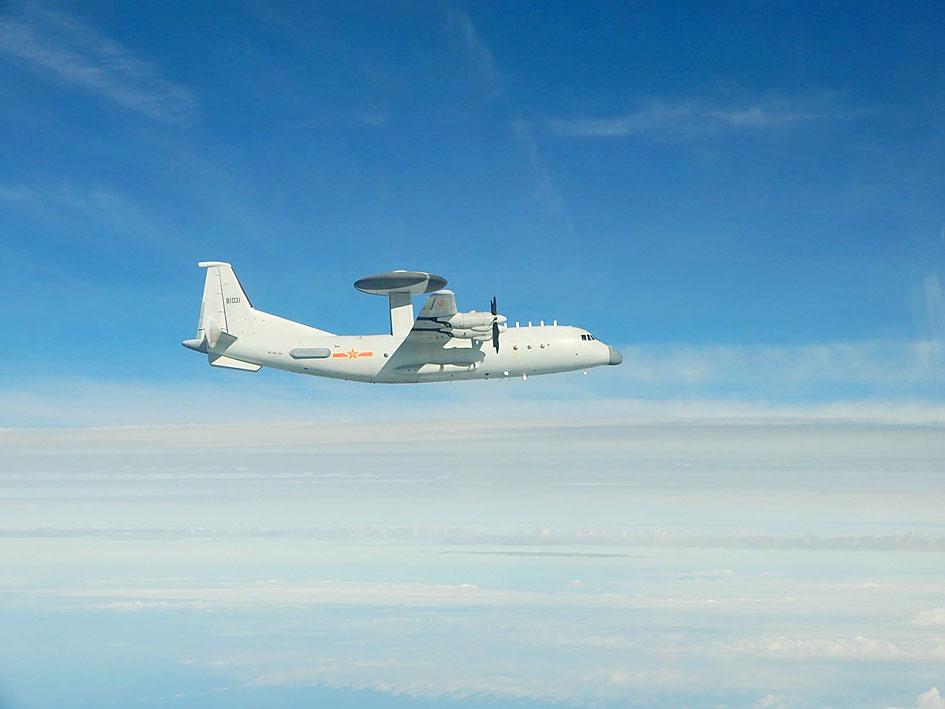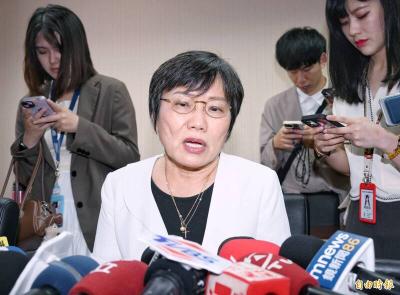The air force yesterday scrambled to warn away 18 Chinese aircraft that entered the nation’s air defense identification zone (ADIZ), the Ministry of National Defense said, part of what is a regular pattern of incursions that has angered Taipei.
Taiwan has complained of repeated such missions by Chinese aircraft, which have become a common occurrence over the past two years or so.
Taiwan is in a heightened state of alert due to fears China could use Russia’s invasion of Ukraine to make a similar military move on the nation, although the government has not reported any signs Beijing is about to attack.

Photo courtesy of the Ministry of National Defense
The number of aircraft involved was well off the last large-scale incursion, 39 Chinese aircraft on Jan. 23, and since then, such flybys have been with far fewer aircraft.
The ministry said the latest mission included six Chinese J-11 and six J-16 fighters, as well as two H-6 bombers.
There was no immediate comment from the Chinese Ministry of National Defense. China has described previous such missions as to defend the nation’s sovereignty and to counter “collusion” with foreign forces — a veiled reference to US support for Taiwan.
The bombers, accompanied by a Y-8 anti-submarine aircraft, flew to the south of Taiwan through the Bashi Channel that separates the nation from the Philippines.
The other aircraft flew over an area to the northeast of the Taiwan-controlled Pratas Islands (Dongsha Islands, 東沙群島) at the top end of the South China Sea, according to a map provided by the Taiwanese ministry.
Taiwanese fighters were sent up to warn the Chinese aircraft and air defense missiles were deployed to “monitor the activities,” it said, using standard wording for how Taiwan describes its response.
No shots have been fired and the Chinese aircraft have not been flying in Taiwan’s air space, but in its ADIZ.
Japan this week reported eight Chinese naval vessels, including an aircraft carrier, passed between islands in Japan’s southern Okinawa chain, to the northeast of Taiwan.

Chinese Nationalist Party (KMT) Chairman Eric Chu (朱立倫), spokeswoman Yang Chih-yu (楊智伃) and Legislator Hsieh Lung-chieh (謝龍介) would be summoned by police for questioning for leading an illegal assembly on Thursday evening last week, Minister of the Interior Liu Shyh-fang (劉世芳) said today. The three KMT officials led an assembly outside the Taipei City Prosecutors’ Office, a restricted area where public assembly is not allowed, protesting the questioning of several KMT staff and searches of KMT headquarters and offices in a recall petition forgery case. Chu, Yang and Hsieh are all suspected of contravening the Assembly and Parade Act (集會遊行法) by holding

PRAISE: Japanese visitor Takashi Kubota said the Taiwanese temple architecture images showcased in the AI Art Gallery were the most impressive displays he saw Taiwan does not have an official pavilion at the World Expo in Osaka, Japan, because of its diplomatic predicament, but the government-backed Tech World pavilion is drawing interest with its unique recreations of works by Taiwanese artists. The pavilion features an artificial intelligence (AI)-based art gallery showcasing works of famous Taiwanese artists from the Japanese colonial period using innovative technologies. Among its main simulated displays are Eastern gouache paintings by Chen Chin (陳進), Lin Yu-shan (林玉山) and Kuo Hsueh-hu (郭雪湖), who were the three young Taiwanese painters selected for the East Asian Painting exhibition in 1927. Gouache is a water-based

Taiwan would welcome the return of Honduras as a diplomatic ally if its next president decides to make such a move, Minister of Foreign Affairs Lin Chia-lung (林佳龍) said yesterday. “Of course, we would welcome Honduras if they want to restore diplomatic ties with Taiwan after their elections,” Lin said at a meeting of the legislature’s Foreign Affairs and National Defense Committee, when asked to comment on statements made by two of the three Honduran presidential candidates during the presidential campaign in the Central American country. Taiwan is paying close attention to the region as a whole in the wake of a

OFF-TARGET: More than 30,000 participants were expected to take part in the Games next month, but only 6,550 foreign and 19,400 Taiwanese athletes have registered Taipei city councilors yesterday blasted the organizers of next month’s World Masters Games over sudden timetable and venue changes, which they said have caused thousands of participants to back out of the international sporting event, among other organizational issues. They also cited visa delays and political interference by China as reasons many foreign athletes are requesting refunds for the event, to be held from May 17 to 30. Jointly organized by the Taipei and New Taipei City governments, the games have been rocked by numerous controversies since preparations began in 2020. Taipei City Councilor Lin Yen-feng (林延鳳) said yesterday that new measures by